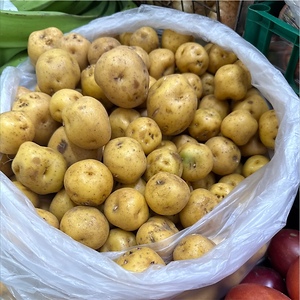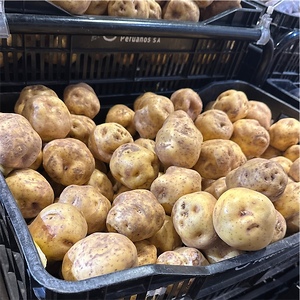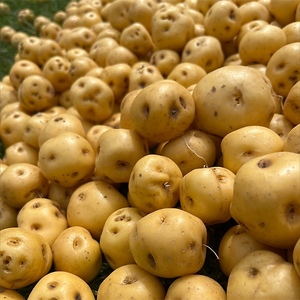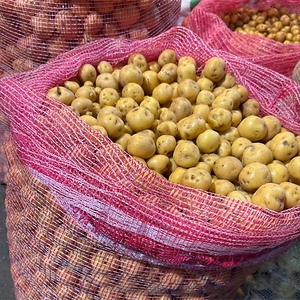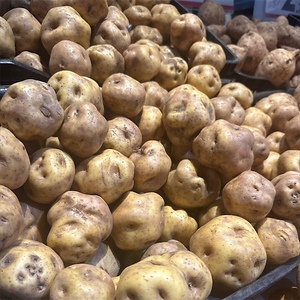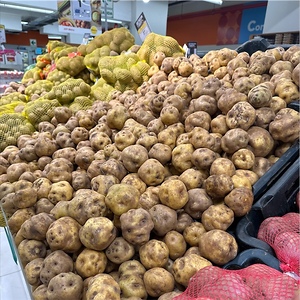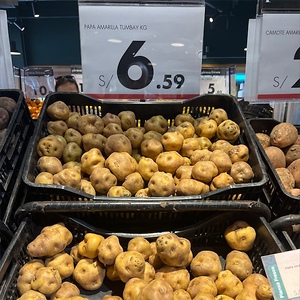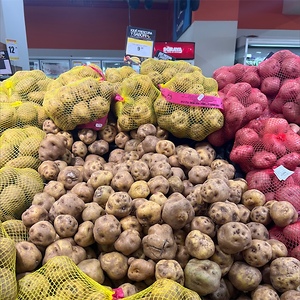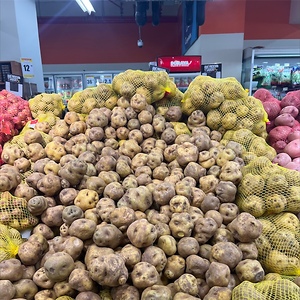


Amarilla Tumbay Potatoes
Estimated Inventory, lb : 0
Description/Taste
Amarilla Tumbay potatoes vary in size and shape, depending on growing conditions, and generally average 5 to 8 centimeters in diameter and 6 to 10 centimeters in length. The tubers sometimes showcase an irregular shape, created from the indentations of deep-set eyes, and are also round to oval with a slightly flattened nature. The semi-thin skin is smooth, taut, and lightly textured, appearing in variegated shades of golden yellow-brown with dark brown markings. The deep-set eyes also often have a dark brown coloring. Underneath the surface, the rich, golden-yellow flesh is dense, firm, and slippery when raw, becoming soft, tender, and grainy when cooked. Amarilla Tumbay potatoes have a high dry matter content and remain somewhat firm and creamy when cooked correctly. The variety is only edible cooked and has an earthy, subtly sweet, nutty, and faintly herbal flavor.
Seasons/Availability
Amarilla Tumbay potatoes are available year-round, with a peak harvest from May through July.
Current Facts
Amarilla Tumbay potatoes, botanically classified as Solanum tuberosum, are a Peruvian variety belonging to the Solanaceae or nightshade family. The tubers are a type of yellow-fleshed native potato, also referred to as papa nativa, and have been cultivated throughout high elevations of the Andes Mountains as a food source. It is important to note that the name Amarilla Tumbay potatoes is a category used for several varieties of native potatoes. The most common variety associated with Amarilla Tumbay is Yuraq Tumbay, a yellow-skinned and yellow-fleshed cultivar valued for its flavor. The other main variety is known as Tumbay Rosas, a floury tuber with a robust aroma and taste. Historically, Amarilla Tumbay potatoes have been grown in the Peruvian Andes since pre-Columbian times, and in the modern day, the tubers have been selected for commercial cultivation. Amarilla Tumbay potatoes are still grown throughout the highlands and are hand-harvested for sale in local markets throughout Peru. The variety is valued commercially for its flavor, coloring, and texture, utilized in a wide array of traditional and modern culinary preparations.
Nutritional Value
Amarilla Tumbay potatoes have not been extensively studied for their nutritional content. Like other yellow-fleshed varieties, the tubers may be a source of fiber to regulate the digestive tract, iron to develop the protein hemoglobin for oxygen transport through the bloodstream, and vitamin C to strengthen the immune system. Potatoes also provide calcium to protect bones and teeth, potassium to balance the fluid levels within the body, phosphorus to repair tissues, and other nutrients, including zinc, magnesium, and manganese.
Applications
Amarilla Tumbay potatoes have an earthy, subtly sweet, and nutty taste suited for cooked preparations. The variety is known for having a thick, soft, and textured flesh, and the tubers are typically steamed and served as a simple side dish. Amarilla Tumbay potatoes must not be overcooked, or they can fall apart, but their dense flesh is savored in soups, stews, and chowders. Ajiaco and carapulca are traditional stew-like recipes that commonly incorporate Amarilla Tumbay potatoes. The tubers are also roasted in pachamanca, an ancient style of cooking in the Peruvian highlands that uses an underground oven. Amarilla Tumbay potatoes can be mashed and served as a side, stuffed with meats and fried in a popular recipe called papas rellenos, or layered in causa Limeña, a dish of stacked layers of mashed potato, meat, and vegetables. They can also be cooked and slathered in melted cheeses and sauces, such as in papa a la huancaina. Try mixing Amarilla Tumbay potatoes into casseroles and comfort food dishes, including aji de gallina, or slicing them into thin strips and frying them into chips. The tubers can also be sliced and cooked into fries, served as a stand-alone dish, or tossed into lomo saltado, a Peruvian Chinese stir-fry. Amarilla Tumbay potatoes pair well with aromatics such as garlic, onions, and chile peppers, tomatoes, bell peppers, squash, corn, and carrots, meats including beef, poultry, and pork, and herbs such as cilantro, parsley, mint, and oregano. Whole, unwashed Amarilla Tumbay potatoes will keep for several months when stored in a cool and dry location.
Ethnic/Cultural Info
Amarilla Tumbay potatoes are mainly produced in the Huánuco region in Peru and are regarded as the “Queen” of Peruvian yellow potatoes for their flavor. The variety is also nicknamed “egg potato” as the tuber’s coloring and texture, when cooked, are similar to the golden yolk of hard-boiled eggs. Each May, yellow potato varieties grown in Huánuco are highlighted and promoted at the Fiesta de la Papa Amarilla. The annual celebration was established over twenty-three years ago through the Regional Directorate of Agriculture of Huánuco and is a three-day festival to celebrate potatoes. Yellow-fleshed potatoes are a symbol of the Huánuco region, and the festival unites potato growers, other industry professionals, culinary students, and food enthusiasts. The Yellow Potato Festival features educational talks, networking events, a variety of exhibitions, and live cooking demonstrations to boost potato production and consumption. One of the most notable events of the 2024 festival was the “largest stuffed potato in the world,” an attraction where over 15,000 dishes of papas rellenas were served to festival attendees. Local culinary students also created new recipes using yellow potatoes, including a potato substitute for noodles in lasagna and bread in burger buns.
Geography/History
Amarilla Tumbay potatoes are native to South America and are thought to be descendants of wild varieties that grew naturally throughout the highlands of the Andes mountains. Much of the history of the variety is unknown, as little written records were left before the arrival of the Spanish, but it is believed that Amarilla Tumbay potatoes are a native variety to central Peru and have been cultivated since pre-Columbian times. Potatoes were selectively bred throughout history for improved flavor, texture, and cultivation characteristics, and the high-elevation regions of the Andes Mountains created an environment with distinct soil, atmospheric pressure, and climate to create an unusual terroir. Over time, Amarilla Tumbay potatoes have remained mainly localized to Peru, but the variety is increasing in notoriety as a commercial cultivar in South America. The variety has also won awards abroad for its flavor in various potato competitions, including the Potato Exhibition in Crevan, France 1993. Amarilla Tumbay potatoes are prevalent in the Peruvian regions of Huánuco, Huancavelica, Apurimac, Pasco, and Junín and grow in elevations from 2,800 to 3,800 meters above sea level. Today, Amarilla Tumbay potatoes are sold throughout their native growing regions and are also sent to cities throughout Peru as a commercial native variety in supermarkets. On a smaller scale, the variety is found in markets in neighboring South American countries. The Amarilla Tumbay potatoes featured in the photograph above were sourced through markets in Lima, Peru.



